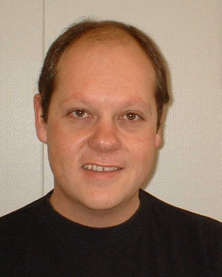Ion selective gates; Active device component for 3D micro fluidic architecture
Promotion Date: 25 February 2005
| The current microfluidic devices comprise mostly one plane. I have found a way to enable communication between different planes. So you do not need to have all the components parallel, but can also go up - thus stacking the components on top of each other. A gate is obviously something you can open or close at will. Basically what I have been doing is finding a way to either let things through or stop the flow externally. The gate is a membrane with a selective layer that allows transport of ions or liquids by applying an electric field over the gate. This can also be applied in other field of membrane technologies. |
What was your thesis about?
The current microfluidic devices comprise mostly one plane. I have found a way to enable communication between different planes. So you do not need to have all the components parallel, but can also go up - thus stacking the components on top of each other. A gate is obviously something you can open or close at will. Basically what I have been doing is finding a way to either let things through or stop the flow externally. The gate is a membrane with a selective layer that allows transport of ions or liquids by applying an electric field over the gate. This can also be applied in other field of membrane technologies.
And of course the device is on a nanoscale?
The ones I have been working with are not. It is really a new idea. There are not so many people in research that are working on this. It is easier to start on something bigger and show proof of principle of the system before developing it on a nanoscale. Also there is no real necessity to go to actual nanosizes.
What is the actual advantage of your system?
The way I see microfluidics is that you want to put a lot of things in an area as small as possible. But ‘many things’ would mean increasing the size. But if you could make something in one level and then transport the product to a next level, process it further etc., you are creating a very efficient device. The nice thing also about my device is that you can run it in different transport modes: transport of ions with a limited electric field and with an increase of the electric field you go overcome the barrier and enable transport of liquids. So it is very versatile. The new thing about this system that contrary to the belief that silicon and oxide ceramic materials cannot be easily incorporated, we showed that you can actually use these ceramic materials and successfully incorporate them into silicon technology.
How is the electricity applied?
For my thesis I used external electrodes but I also showed what happens if you put them on the membrane. That is a bit more tricky to get it to work, - it does work, but the lack of cohesion between the gold layer or platinum on the membrane presents problems.
There is still work to be done before the realization of an actual application.
But still, this means real progress?
Yes it does.
Did you write publications and go to conferences?
I did not always go myself, sometimes my supervisor went, but I have been to Toulouse, and St Petersburg. I got some very nice publications, one in Advanced Materials and one in Analytical Chemistry.
On the whole this all sounds very successful. Have you also experienced something for a setback over the past 4 years?
If anyone says ‘no’ they are lying! I was lucky in the first year. I showed with really crude experiments that my idea would work. Then we started to refine the experiments and nothing worked anymore for a year. It was not the best year of my life. But things went well after that.
How can it happen?
Well, in the beginning you do not really understand the processes that are going on. So also in the year that things do not work, you learn a lot.
If you do research you obviously have to have a certain amount of knowledge. But certainly you also need a certain amount of luck. And I never lost my confidence, because I simply knew it could be done. And I had a supervisor who really helped me think.
What did you like best?
I enjoyed working in the lab, doing things with my hands. When there is a nice atmosphere and everybody gets a long it is really a pleasure going to work everyday. And when you enjoy your work, you enjoy life I always think.
Where are you from?
South Africa, not to far from the Pretoria/Johannesburg region.
How did you get to Mesa?
I started my PHD in South Africa with a Professor from the Netherlands and he was starting the membrane group in our chemistry department. I told him I would like to do my PHD outside of South Africa and he arranged an interview here.
Did you enjoy doing your PHD in the Netherlands?
I really needed some time to adapt. You start doing a PHD which is a major step, and I stepped into a completely different world besides. Africa is run on African times. Here everything goes by the clock, which certainly has advantages but I had to get used to it. I had extreme difficulty with the weather, months of rain and grey clouds get to you when you are from a sunny country like where I come from. That took me two years at least. In the end I am really glad I came: it has been an experience that I would not trade for anything.
For the summary of the thesis, click here.

